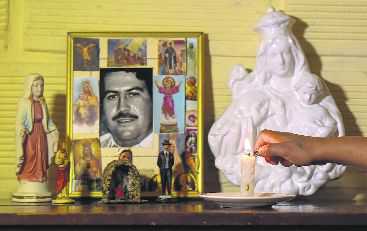25 yrs on, Pablo Escobar’s dark legacy refuses to die
Medellin, December 2
Twenty-five years after he was gunned down by the police, Pablo Escobar’s legacy refuses to die in Medellin, the Colombian city where he ran his cocaine empire with a mix of brutality and largesse.
Even as city officials prepare to demolish the bunker-like mansion where the late drug lord lived, in the neighbourhood that bears his name residents who live in homes he built for them are planning heartfelt tributes to mark Sunday’s anniversary.
Escobar was killed in a rooftop shootout in Medellin on December 2, 1993, one day after his 44th birthday. His eight-story mansion, the Monaco, a symbol of the decadent opulence of the Colombian mafia in the 1980s and 90s, has fallen into disrepair in the years since his death.
The hulking white building is slated to be demolished in February, in a public implosion complete with stands for viewers to watch. “The Monaco has become an anti-symbol, in a place where some people are outspoken defenders of crime and terrorism,” says Manuel Villa, the city hall secretary who will perform the official countdown to the detonation.
The mansion, a top tourist attraction in Medellin’s upscale El Poblado neighbourhood, will be replaced by a public park dedicated to the thousands of people killed in Colombia by “narcoterrorism”.
“It will be painful” to tear it down, says Villa, “but it’s the only way we can heal our wounds.” Colombian society remains deeply divided over the legacy of Escobar and other drug barons. — AFP
Unlock Exclusive Insights with The Tribune Premium
Take your experience further with Premium access.
Thought-provoking Opinions, Expert Analysis, In-depth Insights and other Member Only Benefits
Already a Member? Sign In Now










